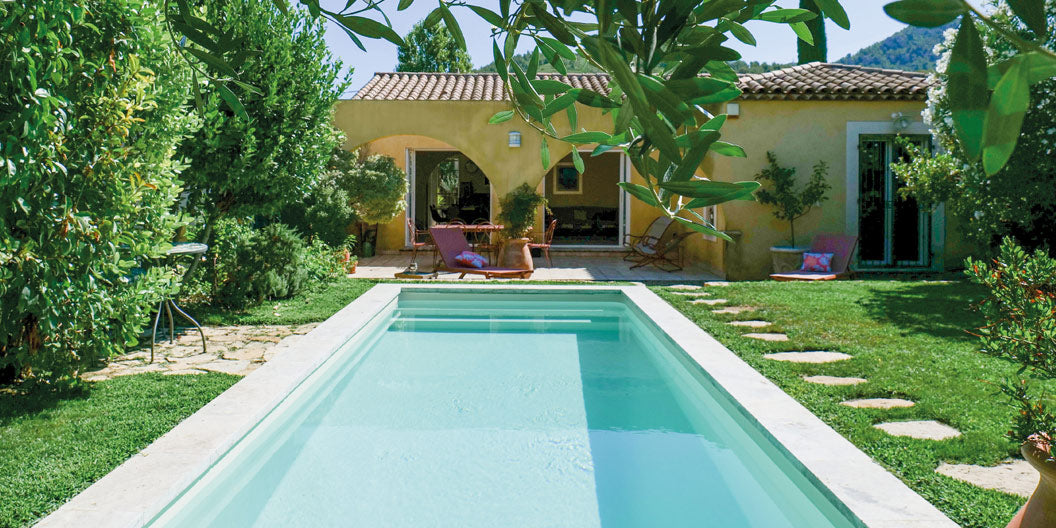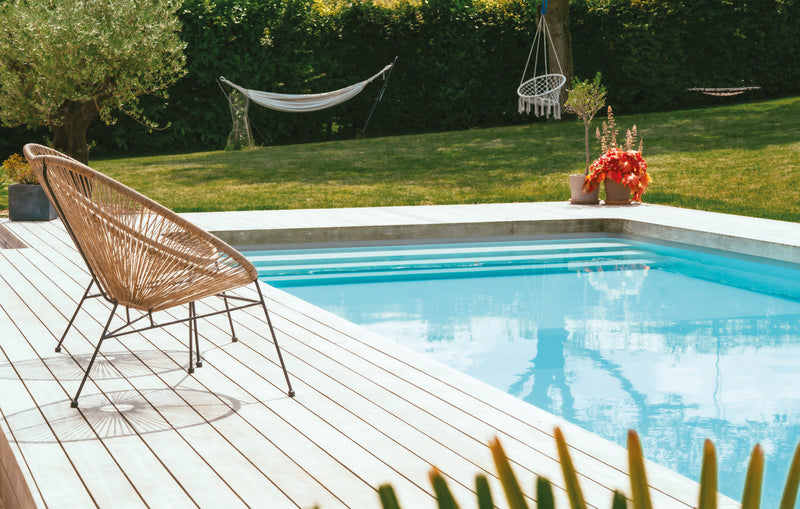- Welcome
- Desjoyaux advice
- fr_FR
-
Our tips for keeping your liner looking young
Our tips for keeping your liner looking young
Posté leMaintaining youthful-looking eyeliner is something we all want. Here are our tips for slowing down the process and preserving your eyeliner.

Your liner is a PVC sheet that is particularly sensitive to chemical and thermal variations. These are often the cause of creases.
Chemical variations:
During their manufacture, liners receive mineral fillers to perfect their appearance, rigidity, resistance, etc. Excessive acidity of the water will dissolve these fillers and the liner will therefore soften, it will become loaded with humidity and fine lines will appear. The main instructions to follow are as follows:
The pH should be between 7.0 and 7.4 (an acidic pH chemically attacks the liner).
The chlorine level must be between 0.7 and 1.5g/m 3 (ppm).
Thermal variations:
Thermal variations are mainly due to excessive heating of the pool water (> 28°C), the presence of a shelter , an automatic cover or in indoor pools . It is recommended to avoid any excess temperature in order to prevent the sheet from expanding, losing its mechanical characteristics at the risk of creases appearing. Creases are frequently located on the panels (unlike the creases of chemical variations mainly located at the bottom of the pool).
In addition to the appearance of wrinkles, blemishes are also a known scourge for our liners. Several types of blemishes can be identified, and preventing their appearance is linked to following certain guidelines.
| Nature of the disorder | Possible Cause(s) | Response(s) and remedy(ies) | |
| Colored waters | Green waters | Insufficient disinfection (algae) | Check pH and chlorine. Perform shock treatment/JD Flash. If treatment is ineffective, use super-stabilization. |
| Colored waters | Recurring green water despite treatment | Presence of phosphates | Phosphate control. Below 100 ppm. Treat with JD Anti-phosphates. |
| Colored waters | Whitish waters | Limescale precipitation / pH and TH too high. Algae decomposing after disinfection. Insufficient disinfection | Check and adjust the pH if necessary. Clarify the water using JD Cristal. Continuous filtration (XXL bag if necessary) |
| Colored waters | Tinted clear waters (Brown / Green / Red / Purple) | Presence of metallic salts (Iron/Copper/Manganese, etc.). Drilling water | Treat with metal sequestrant (JD STOP metals). Adjust the pH to 7.5 or 7.6, clarify the water (JD Cristal) and filter continuously. |
| Water treatment malfunction | Rough walls | Water too hard, pH too high. Limescale precipitation on the bottom and walls | Proceed with intensive brushing of the walls. If ineffective, contact your partner. |
| Water treatment malfunction | pH instability | Insufficient TAC or influence of disinfectant. | Poor water balance, correct TAC (TAC +). Change disinfectant. |
| Water treatment malfunction | Treatment products disappear quickly | Stabilizer missing. Pool too polluted / Filtration time too short. High water temperature. | Increase stabilizer. Adjust pH/TAC/TH and perform shock treatment/JD Flash. Adjust filtration time (water temperature). |
| Water treatment malfunction | Fragrant, aggressive waters that irritate the eyes | Excess chloramines or pH too low | Reinforce disinfection. Check pH/chlorine and adjust if necessary. |
| Water treatment malfunction | Yellow deposits, sandy appearance, close to pollen on the bottom of the stairs and basin corners | Mustard algae. Repeated volatile deposit. | Check and adjust the pH. Apply an Anti-mustard algae treatment (JD Mustard Algae) combined with shock chlorination or JD Flash. Complete cleaning of the pool and filter bags. |
| Water treatment malfunction | Pink, red algae | Presence of bacteria. High pH, disinfection too weak. | Check pH and adjust it. Perform shock treatment + JD Flash, combined with a concentrated algaecide treatment. |
| Stains on the coating | Discoloration of the membrane underwater | Concentration of oxidizing products. Normal degradation depending on the age of the coating | Discoloration is generally irreversible. |
| Stains on the coating | Rough whitish walls below the water line | Limestone deposit. | Adjust the water balance. Clean the waterline with a suitable product. Add anti-limescale (sequestrant). Stains are generally irreversible depending on the age of the coating. |
| Stains on the coating | Yellow, orange-pink spots at the waterline | Pollens, agricultural treatments, self-tanning sunscreen or pollution | |
| Stains on the coating | Brown or black spots | Presence of metal ions. Accidental iron filings in the basin. Borehole or catchment water | Metal sequestrant. |
| Stains on the coating | Brown or black spots | Presence of algae. Decomposing leaves at the end of winter. Water infiltration behind the liner. | pH adjustment, brushing, and intense sweeping without abrasives. Disinfection and concentrated anti-algae treatment. Some stubborn stains at the end of winter may be irreversible. |
| Stains on the coating | Brown or black spots | Microorganisms behind the liner. | Full pool with intense shock chlorination and continuous filtration for 24/48 hours. If this is ineffective, contact your partner. |
| Stains on the coating | Brown or black spots | Fatty deposits / Presence of sunscreen. Hydrocarbons | Cleaning the waterline with a suitable product (liquid or gel) depending on the strength of the deposits. |

